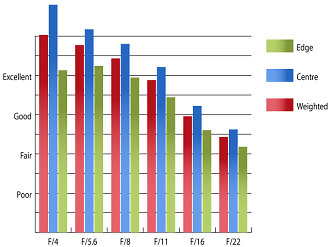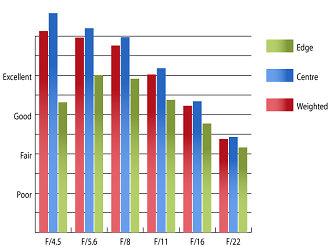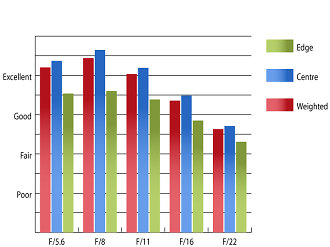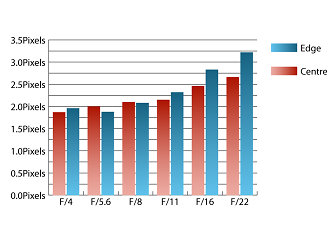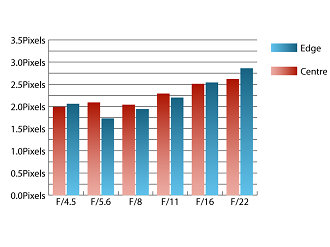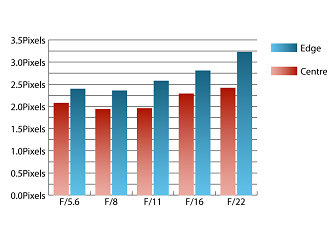Samsung 12-24mm f/4-5.6 ED Lens Review
Samsung 12-24mm f/4-5.6 ED Performance
At 12mm and maximum aperture, sharpness is already excellent across the frame, and even outstanding in the centre. At this focal length, diffraction appears to be the limiting factor on clarity, with the performance of the lens reducing as the aperture is stopped down.
Zooming to 18mm results in similar performance, with outstanding sharpness in the centre of the frame at maximum aperture, although excellent sharpness isn’t achieved towards the edges of the frame until the aperture is stopped down to f/5.6 for this focal length.
Finally, at 24mm, sharpness remains excellent in the centre of the frame at maximum aperture, and is still very good towards the edges of the frame. Stopping down to f/8 results in a slight increase in performance in the centre.
How to read our charts
The blue column represents readings from the centre of the picture frame at the various apertures and the green is from the edges. Averaging them out gives the red weighted column.The scale on the left side is an indication of actual image resolution. The taller the column, the better the lens performance. Simple.
For this review, the lens was tested on a Samsung NX30 using Imatest.
Chromatic aberrations are a problem with this lens throughout the zoom range and especially at slower apertures, where fringing towards the edges of the frame can exceed three pixel widths. Care may need to be taken when shooting high contrast subjects with this lens as a result.
How to read our charts
Chromatic aberration is the lens' inability to focus on the sensor or film all colours of visible light at the same point. Severe chromatic aberration gives a noticeable fringing or a halo effect around sharp edges within the picture. It can be cured in software.Apochromatic lenses have special lens elements (aspheric, extra-low dispersion etc) to minimize the problem, hence they usually cost more.
For this review, the lens was tested on a Samsung NX30 using Imatest.
Falloff of illumination towards the corners is extremely well controlled throughout the zoom range, remaining consistent with corners being 0.7 stops darker than the image centre at maximum aperture. Stopping down by one stop from maximum aperture results in visually uniform illumination.
Distortion is well controlled for an ultra-wide angle lens, with barrel distortion ranging between 3.5% at 12mm and 1% at 24mm. These levels are low enough that they will rarely require correction, but if they do, you'll be glad to know that the distortion pattern is uniform across the frame, which should make applying any corrections, relatively straightforward.
A petal-shaped lens hood is provided with this lens as standard, which does a fair job of shading the lens from extraneous light that may cause flare of loss of contrast, although due to the wide field of view of the lens, the hood cannot be any deeper. There were no issues with flare encountered during testing, but shooting into the light does result in a noticeable loss of contrast.
Value For Money
Taking into account how this lens performs, the asking price of £320 seems quite reasonable. As there are currently no alternatives available from other manufacturers Samsung have a monopoly in this instance.
Add your message
Please login here or if you've not registered, you can register here. Registering is safe, quick and free.
photodo Stats
428 MTF tests
74 in-depth photodo reviews
100+ users join each day
Help the lens community by reviewing or rating a lens today via our lens search
Latest Lens Reviews
- Chinon 28mm f/2.8 Vintage Lens Review
- Canon EF 70-200mm f/4L IS II USM Lens Review
- Samyang AF 85mm f/1.4 EF Review
- Sigma 70mm f/2.8 DG Macro Art Review
- Samyang AF 24mm f/2.8 FE Review
- Meike 50mm f/1.7 Review
- Tamron 70-210mm f/4 Di VC USD Review
- Lensbaby Burnside 35mm f/2.8 Review
- Asahi Super Takumar 50mm f/1.4 Review
- Asahi Super-Multi-Coated Takumar 135mm f/3.5 Review
